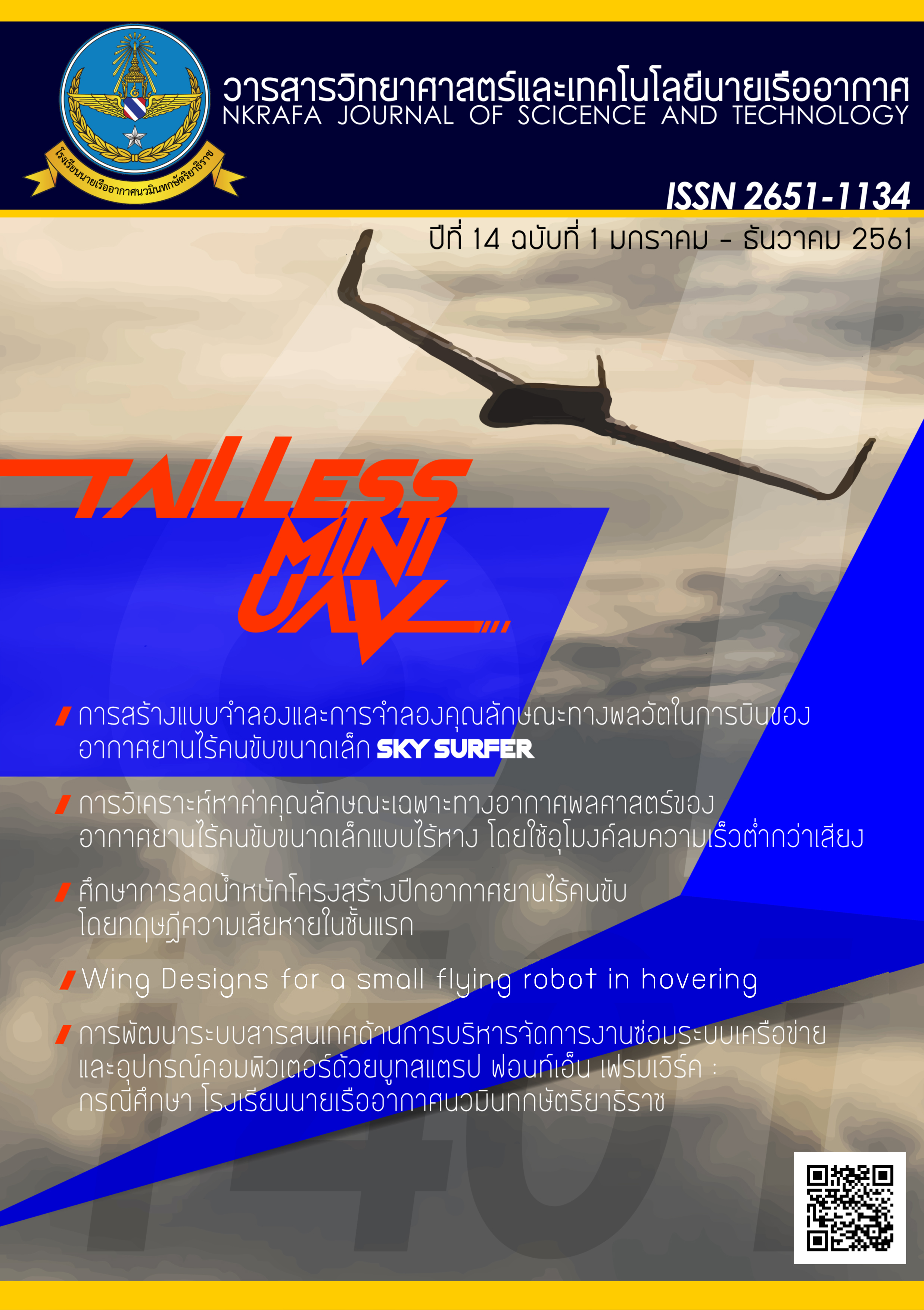Weight Reduction Study of UAV Wing by Using 1st Ply Failure Theory
Main Article Content
Abstract
This paper presents a method to reduce the weight of a small Unmanned Aerial Vehicle (UAV) which uses in the surveillance and reconnaissance flight for information mission. This wing is constructed in according to the EAA standard. Though, the amount of flight is more than 50 times the wing is still in good condition. If the wing weight is reduced the payload could be increased. This research estimates the strength of wing skin made of stacking layers of composite materials by finite element method. The mechanical properties of each layer is lamina and composed of fiber fabric and epoxy resin. The wing structure model is meshed in small triangular named thin shell element so that the stress state is approximate as plane stresses. Thus, the stress arisen in a ply reaching the maximum stress will be the 1st ply broken using the Maximum Von Mise stress as indicator. The result of the Finite Element Method (FEM) simulation emphases that the mass is reduced 46.54 %
Article Details
- Content and information in articles published in NKRAFA Journal of Science and Technology are comment and responsibility of authors of articles directly. Journal editorial do no need to agree or share any responsibility.
- NKRAFA Journal of Science and Technology Articles holds the copyright of the content, pictures, images etc. which published in it. If any person or agency require to reuse all or some part of articles, the permission must be obtained from the NKRAFA Journal of Science and Technology.
References
[2] GAY, D. (2015). Matériaux Composites. 6th Ed. Paris: Lavoisier Hermés,.
[3] จีรศักดิ์ หมวดโพธิ์กลาง. (2559). การควบคุมตำแหน่งอากาศยาน 4 ใบพัดโดยใช้ระบบการเห็นภาพ. วารสารวิชาการนายเรืออากาศ, 12(12): 17-21.
[4] เจนวิทย์ คำพูล. (2560). การวิเคราะห์อากาศพลศาสตร์ เสถียรภาพและการควบคุมของอากาศยานไร้คนขับขนาดเล็ก Sky Sufer X. วารสารวิชาการนายเรืออากาศ, 13(13): 25-33.
[5] วันชัย เจียจันทร์, กนก ทองสว่าง และนุกูล สุขุประการ (2560). การศึกษาและวิเคราะห์อากาศพลศาสตร์ ของแพนอากาศและปีกของอากาศยานไร้คนขับแบบไร้หาง. วารสารวิชาการนายเรืออากาศ, 13(13): 34-44.
[6] Tetsuya Morimoto, Satoshi Kobayashi, Yosuke Nagao, & Yutaka Iwahori. (2507). A new cost/weight trade-off method for airframe material decisions based on variable fuel price. Japan: Cogent Engineering.
[7] สมชาย หาญกล้า, กอบ พืชผา, บุญเลิศ อันดารา, ปริพนธ์ สุขพิมาย และคณะ. (2559). การออกแบบ สร้าง และทดสอบโครงสร้างปีกของอากาศยานไร้คนขับระยะใกล้. วารสารวิชาการนายเรืออากาศ, 12(12): 9-16.
[8] ณัฐพล นิยมไทย. (2547). โปรแกรมสำเร็จรูปการแผนแบบอากาศยาน Paksin. โครงการวิจัยและพัฒนาอากาศยานไร้คนขับ สกว.และสวพ.กห.
[9] Zienkiewicz, O.C., & others. (2005). The Finite Element Method Set, 6th Ed. Butterworth-Heinemann: Elsevier Ltd.
[10] Batoz, J.L., & Dhatt, G. (1992). Modélisation des Structures par elements finis. Paris: Hermès.
[11] Careera, E. (2002). Theories and Finite Elements for Multilayered, Anisotropic, Composite Plates and Shells, Arch. Comput. Meth. Engng. 9(2): 87-140.
[12] วีระศักดิ์ อุดมกิจเดชา. (2544). อุตสาหกรรมสิ่งทอไทย. กรุงเทพมหานคร: โรงพิมพ์แห่งจุฬาลงกรณ์มหาวิทยาลัย.
[13] ฉัตรินทร์ สุนสิน และคณะ. (2556). การทดสอบโมเมนต์ดัดเพื่อหาสมบัติทางกลของไม้อัดสำหรับโครงสร้างแซนด์วิชผสมระหว่างไม้อัดกับกระดาษรังผึ้ง, Me-Nett 2013. ชลบุรี.
[14] Biron, M. (2014). Thermosets and Composites Technical Information for Plastics Users. 2nd Ed. Oxford: Elsevier Ltd..
[15] Schrenk, O. (1940). Schrenk’s Method Distributed Load A Simple Approximation Method for Obtaining the Spanwise Lift Distribution. NACA. Washington, D.C., 7(4): 118-120.
[16] Camanho, P.P. (2002). Failure Criteria for Fibre-Reinforced Polymer Composites, DEMEGI, 1-13.
[17] Akin, J. Ed. (2009). Finite Element Analysis Concepts via SolidWorks, Houston: World Scientific.


